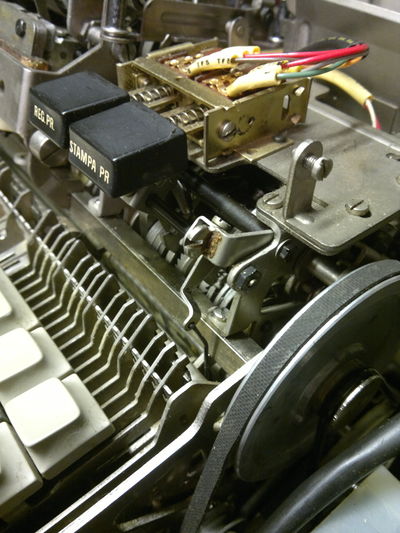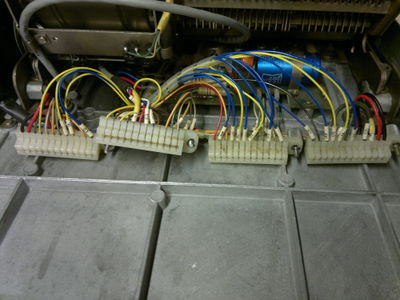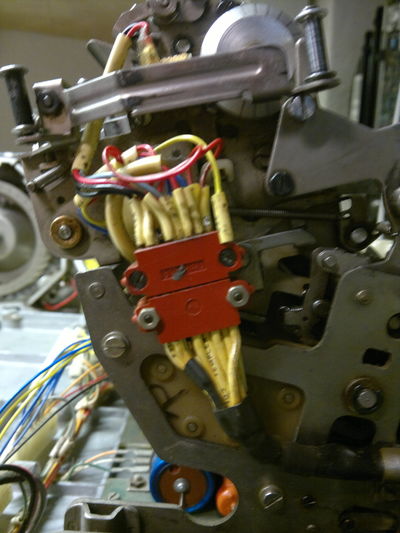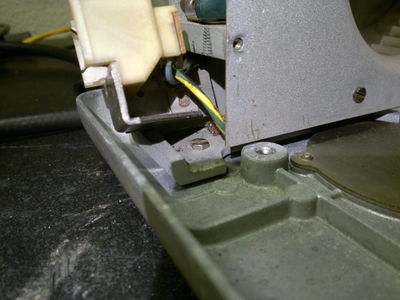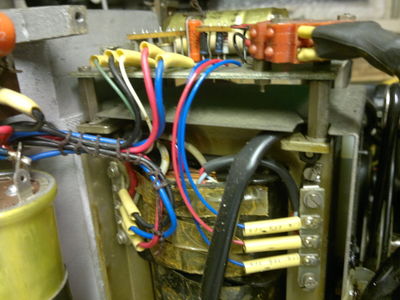| Regel 70: | Regel 70: | ||
GRMBH. Today I found out that I took a wrong pin for monitoring the AK signal. I have correted this and will be reassemble the electronics module shortly to recheck the switches. But first I have to make some pictures of the boards and backplane | GRMBH. Today I found out that I took a wrong pin for monitoring the AK signal. I have correted this and will be reassemble the electronics module shortly to recheck the switches. But first I have to make some pictures of the boards and backplane | ||
| + | |||
| + | === 16 dec 2014 13:37 (CET) === | ||
| + | |||
| + | Today Huge progress. Even as to say that I got the result of the square root of 6 out of it! But that was a long way to go. After I took the pictures and reassembled the machine, I took anothr look at the AK switch mechanism. As it turns out it was not working properly. Prodding some parts I discovered that the AK coding bar did not move freely, so the AK control latch did not return to its AK Control Bridge blocking position (doc "Olivetti_Programma_101_technical_manual", page 17, Figure 9) It took some time to find out that this coding bar was rubbing against some parts of the keyboard framework between the microswitch slides and the bearings of the bar in the plastic blocks were dry. with some oildrops that was fixed. Put a drop of oil on the thick centerpart of the bar's profile contacting the frame.(its the part touched by legend 7 in fig. 9) the space is very constrianed ans you have only one or two milimeter between the slides and the frame support. The AK coding bar now moves freely and the triggering of the AK switch is prohibited in the first, but possible in the second revolution. | ||
| + | |||
| + | That solved a lot of the reset problems, but not all. :-( After a lot of prodding on connectors and wires things were still erratic. Sometimes the machine starts up with the error light burning and reset working as espected, but on other occasions there would be no lights at all and no reaction to the reseting of the machine. As there are a huge amount of contacts in this machine (more that 850 alone in the electronics module) I decided that it was time for a proven concept: Percusive Maintenance. Using the plastic grip of a screwdriver I started hitting cards and other electonically parts gently while the machine was running with no lights on and Tada.wav: hitting the backplane resulting in the ready light coming up and the machine able to produce the square root of 6. Repeating the procedure after turning the machine off and on again did produce the same results. Well that narrows down the amount of contacts to check from 850 to about 840... Yeah | ||
| + | |||
| + | As I had cleaned the contact surfaces of the cards already that leaves only the counterpart on the backplane to clean and check, meaning taking the complete electronics module apart. That will be the thing for the next time. | ||
== Electronics == | == Electronics == | ||
Versie van 17 dec 2014 09:32
| Project: Repair Olivetti Programma 101 | |
|---|---|
| Naam | Repair Olivetti Programma 101 |
| Door | MacSimski |
| Status | Uitvoer |
| Madskillz | mechanics, electronics, temper control |
| Doel / Omschrijving | |
| Attempt to restore a Programma 101 to working order | |
| Alle Projecten - Project Toevoegen | |
Our Olivetti Programma 101 has been sitting idle in a cellar for at least 10 years. Because of the way the machine is built and its age, all the mechanical parts have gummed up. Grease and oil have turned into a tough goo and the various belts have deteriorated. Checking and fixing the machine is only possible after a thorough cleaning, application of fresh lubricating agents and replacement of all the belts. Afterwards, we will be able to proceed with checking the electronics of this calculator.
Mechanics
The mechanics are divided into several assemblies, fixed to each other and the chassis with sometimes hard to reach screws. It is the earliest known instance of a RISC processor ("Ridiculous Italian Screw Construction"). Some screws are almost unreachable; for some screws you need to stick a very long screwdriver completely through the assembly to reach it.
The major units are:
- Keyboard assembly.
- Printer assembly.
- Servo assembly
- Card reader assembly.
- Motor.
- Main cooling fan.
Progress
After a first internal inspection it was clear that all the mechanical parts had gummed up by old grease and oil and that all the belts save one had turned into goo. Fortunately the machine was not tampered with or "repaired" by an amateur. We proceeded by taking the machine apart when we encountered the now famous "Ridiculous Italian Screw Construction". Especially the card reader and the electronics cage are fitted in this fashion. I made a long flat srewdriver from a piece of long iron to reach for the deep placed screws. Finding the screw underneath the powersocket took some time as well.
The machine taken apart I focused on getting the mechanics working again. The separate assemblies were taken and submerged in Nebol grease cleaner. Belts were removed with care not to spoil the clean surroundings and the path cleaned with Dasty grease remover. Getting the motor running smoothly again turned out to be a strange thing. To get to the gummed up brass bearings, we took apart the motor and cleaned the shaft and bearing with brake-cleaner. After reassembly everything was smooth, but returning the next day we found a gummed up motor on the bench. After a few attempts we discovered that the brass is porous and a piece of oil drenched felt is behind the bearing, regreasing the shaft overnight. So a thorough submerge in nebol fixed that for good.
The pinchroller for the magcards was a different problem. It had gummed up so badly and deformed beyond measurement. 11mm,12mm? we don't know. for now I've cleaned the rod of its remains and took a measurment on the other intact roller. As it is connected to the pinchroller with a belt and pulleys of the same diameter, I think it could well be the right size: 12mm. The pichroller was restored with car gas tubing with 6mm internal and 12mm outer diameter. the pinchroller rod is 5mm diameter, so shrinktubing is used to fill the gap. Works perfectly.
That was the last mechanical hurdle so rebuilding has started now. Only one belt needs to be recreated, but that can only be done after the motor is back on the chassis. When the machine is back in one piece, we will focus on the electronics, starting with the power supply. Fortunately people at the Danish Datamuseum are also working on their 101 and have a rather good repairlog: http://datamuseum.dk/wiki/Olivetti/Programma_101/Revive
16 okt 2014 15:49 (CEST)
Today we finally had the time to test the complete machine. and it's working, kind of. lights come on and go off, keypresses are possible and there is a response on the reset button. but nothing has been printed yet. The strange behaviour could caused by a lazy 5 key. it will not rebound after a press and even when left untouched, it will sink into the keyboard again after a few strokes on other keys. I suspect a missing or broken spring, or a sticky mechanical latch. MacSimski (overleg)
17 nov 2014 21:53 (CET)
Mechanically the machine is ok (except the cardreader. to be fixed as soon as the machine is caclulating again) It takes a lot of presses on reset at power on to get the machine to show its ready light. so something is still not right. I took a PCB out and noticed very dirty and rusty card-edges. so cleaning them with an eraser is now commencing.
18 nov 2014 13:39 (CET)
Cleaning the contacts did not improve matters. although they were indeed very dirty in some places, I do not notice a better working machine. Then thinking over the possibilities, there are a few things left to check:
- still a mechanical timing problem
- problem with the microswitches
- elcos on the various boards off spec or defective
- Memory loop defective
1. and 2. are detectable by using a logic probe on the 12 switches.
3. is by checking with an ESR meter or reforming them.
4. check with a oscilloscope.
As the beaglelogic logic probe is still not operational, but the outcome of the tests influences the working of the machine a lot, I will be focussing on the beaglebone for the time being.
13 dec 2014 15:58 (CET)
Today I noticed that sometimes after pressing the reset button, it takes a while to get a ready light. monitoring the leds connected to the 12 microswitches they behave normally, so my conclusion is now that the electronics are faulty, and probably the elcos. I desoldered one wire from the magneto memory (the red one near the rear of the machine. The ready light would not come on after repeatedly pressing the reset button. After reconnecting the wire, the light does come on after pressing reset. Another thing I did was replace the 6A fuse on the PSU PCB. this specific specimen had a lot of corrosion on its caps and wiggling it when turned on results in sparks. definitely not good. after replacing the fuse, the ready light comes on more often than before.
13 dec 2014 17:00 (CET)
I have replace all the elcos on the memory board: no inprovement. :-( strange thing is that sometimes the readylight comes up after almost a minute after the reset button is pressed. could the memory be faulty? I set up my scope on the white wire of the memory module nearest the keyboard (memory input i think, noticing the high voltage) with the timebase of the scope setup on 0.2ms/div and this gives me one memorycycle. signal is 2V/div and probe is on 1x div. Then I pressed reset repeatedly. [Here] a video of the result.
15 dec 2014 11:25 (CET)
GRMBH. Today I found out that I took a wrong pin for monitoring the AK signal. I have correted this and will be reassemble the electronics module shortly to recheck the switches. But first I have to make some pictures of the boards and backplane
16 dec 2014 13:37 (CET)
Today Huge progress. Even as to say that I got the result of the square root of 6 out of it! But that was a long way to go. After I took the pictures and reassembled the machine, I took anothr look at the AK switch mechanism. As it turns out it was not working properly. Prodding some parts I discovered that the AK coding bar did not move freely, so the AK control latch did not return to its AK Control Bridge blocking position (doc "Olivetti_Programma_101_technical_manual", page 17, Figure 9) It took some time to find out that this coding bar was rubbing against some parts of the keyboard framework between the microswitch slides and the bearings of the bar in the plastic blocks were dry. with some oildrops that was fixed. Put a drop of oil on the thick centerpart of the bar's profile contacting the frame.(its the part touched by legend 7 in fig. 9) the space is very constrianed ans you have only one or two milimeter between the slides and the frame support. The AK coding bar now moves freely and the triggering of the AK switch is prohibited in the first, but possible in the second revolution.
That solved a lot of the reset problems, but not all. :-( After a lot of prodding on connectors and wires things were still erratic. Sometimes the machine starts up with the error light burning and reset working as espected, but on other occasions there would be no lights at all and no reaction to the reseting of the machine. As there are a huge amount of contacts in this machine (more that 850 alone in the electronics module) I decided that it was time for a proven concept: Percusive Maintenance. Using the plastic grip of a screwdriver I started hitting cards and other electonically parts gently while the machine was running with no lights on and Tada.wav: hitting the backplane resulting in the ready light coming up and the machine able to produce the square root of 6. Repeating the procedure after turning the machine off and on again did produce the same results. Well that narrows down the amount of contacts to check from 850 to about 840... Yeah
As I had cleaned the contact surfaces of the cards already that leaves only the counterpart on the backplane to clean and check, meaning taking the complete electronics module apart. That will be the thing for the next time.
Electronics
Before testing the machine, a overhaul of the powersupply is very inportant. I've checked the various capacitors and reformatted them, and only the big 5000uf 50v capacitor was bad. To test the powersupply, we need a dummyload of about 10ohm at 24V, to get a voltage reading of around 20v on the powerline. Pins are p1f and p1m. I've used two car headlight bulbs rated at 60watt each and put them in series. another 21W 12v car bulb was loaded on the minus 10v rail (p3f and p1m). votages are fine.
Links
- The Datamuseum in Denmark is restoring their 101.
- page with signalpaths


